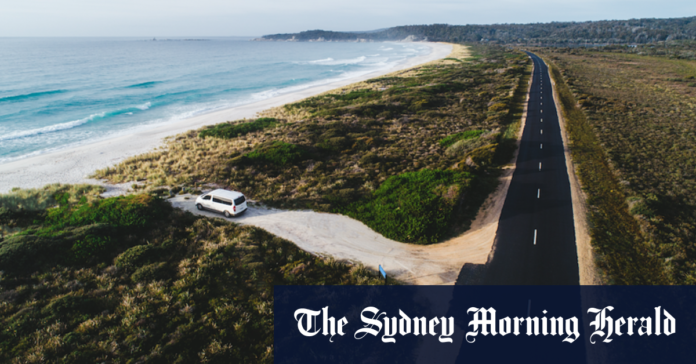For those times when you long to stop the world and enter a calmer headspace, there really is no place like Tasmania for catching your breath.
Angling for calm
Karen Brooks is a professional fly-fishing guide who takes visitors into the beautiful Meander Valley in the state’s central north to catch wild brown trout. She says it offers the ultimate relaxation. “It’s an activity that’s totally absorbing and in the moment,” she says.
“It takes you away from everything else. There’s the anticipation of the day ahead, the looking at the weather, the fly-tying, the behaviour of the fish, the flow of the river. It’s all so engrossing, it’s incredibly lovely.”
Tasmania has arguably the world’s purest strain of wild brown trout, which thrive in thousands of tarns, lakes and rivers across the island. “Being out there, at one with nature, is so special,” Brooks says. “Even if you come away empty-handed at the end of the day!”
Fly fishing, Lake Leake.Credit:Samuel Shelley.
Walk on the wild side
Mind the wombats. There’s wildlife underfoot and overhead on Maria Island, a national park just off the east coast, full of wombats and wallabies, 11 of the state’s 12 endemic bird species and even squealing Tasmanian devils, along with painted rock formations, white sand beaches and convict ruins.
Ben Brown is operations manager of the Maria Island Walk. “It’s a beautiful little island, almost like a miniature condensed version of the whole of Tasmania,” he says.
“The only people living there are a couple of rangers and their car is the only one allowed on the island. So, it’s a great place to unwind in fabulous nature, as well as with a beautiful World Heritage Site that predates Port Arthur and scenery that rivals Wineglass Bay – but without the tourists.”
While the wildlife is remarkable, the human history also comes as a surprise: the island has been a homeland for Tasmanian Aboriginal people, a whaling and sealing station, a penal settlement and an Italianate pleasure resort. Explore by foot, hire a mountain bike or take an e-bike tour – and mind the wildlife.

Maria Island.Credit:Stu Gibson.
Explore with elders
Another way of connecting with magnificent landscapes and an ancient culture is via the four-day wukalina walk, an Aboriginal-owned and operated guided walk in Tasmania’s north-east, through the area commonly known as the Bay of Fires, and increasingly by its traditional name, larapuna.
It’s an enchanting experience, hearing creation stories from the nation’s first people and seeing the world afresh, bathed in a whole new light.
“It is the first walk of its kind,”says wukalina walk’s Warena Burgess, “and it’s groundbreaking in that it is the first time the palawa people have had the chance to tell their story, on their own land, and in their own time. It provides invitation-only access to a cultural homeland, and to a culture completely unique.”
Stand among giants
For outreach ecologist Yoav Daniel Bar-Ness, Tasmania’s most magical moments are among its trees. And the bigger and older, the better. “It’s just life-changing,” he says, “in that you really get a sense of age and the strength of the natural kingdom when you’re exposed to ancient forests where nothing was built by humans. They’re such a natural treasure. It’s not too far off Narnia.”
Bar-Ness runs Giant Tree Expeditions in southern Tasmania and says a walk in the woods is so much more when you’re among the tallest trees in the southern hemisphere: Eucalyptus regnans, also known as swamp gum or mountain ash, which tower up to 100 metres. “We have some of the ultimate trees on the planet here in Tasmania, and arguably the superlative of all flowering plants,” says Bar-Ness, who also loves also being among the big gums and Huon pines.
“Seeing the variety of trees here, and thick jungle that’s also cold and mossy and fragrant, teaches you so much about nature and how Tasmania is so amazing.”
Credit: Source link






























